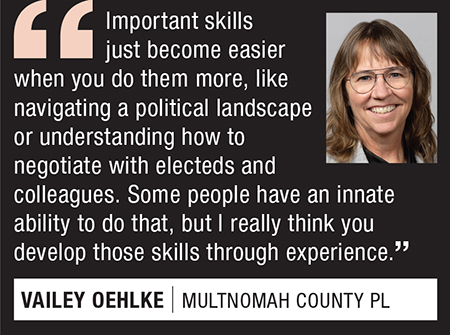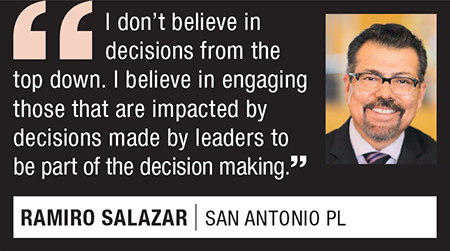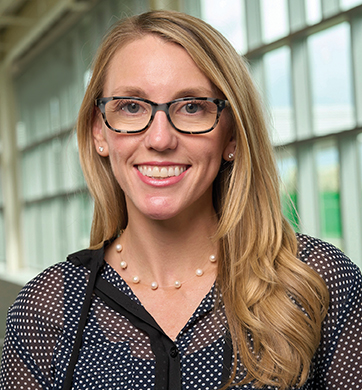Who’s Next?: What Happens When Longtime Library Leaders Retire
As library leaders contemplate retirement, are their libraries—and the next generation of leaders—ready for the change?
As library leaders contemplate retirement, are their libraries—and the next generation of leaders—ready for the change?
While the “Great Resignation” of recent years had a significant impact across all levels of the workforce, new data suggests that leadership turnover is driving change. A recent report from the Federal Reserve Bank of St. Louis estimated 2.4 million excess retirements—meaning retirements beyond those predicted to occur through an aging workforce—as of June 2023. Among those excess retirements, outplacement firm Challenger, Gray & Christmas cited a record-breaking 748 CEO retirements this year, with government/nonprofit CEOs leading all industries as of May.
In libraries, several recent director retirement announcements may be reflective of a broader trend in leadership transitions that have been concentrated over the past 18 to 24 months. “What I think we’re seeing is some compression,” says June Garcia, an executive search consultant. “People who might have had plans to retire during what turned out to be the height of the pandemic postponed their retirement to help their organizations through that. Now that we’re past it, there is a reset with directors asking themselves, ‘Okay, now am I going to retire?’”
HOW THE JOB HAS CHANGED
For three long-tenured, nationally recognized directors—Pat Losinski of Columbus Metropolitan Library (CML), OH; Vailey Oehlke of Multnomah County Library (MCL), OR; and Ramiro Salazar of San Antonio Public Library (SAPL), TX—this year marks their retirements from a combined 56 years in their most recent roles. From weathering the Great Recession to the launch of Kindle ebook borrowing via OverDrive, their time leading three major public library systems overlapped with advancements in the profession and change in American culture. The jobs they exit are different from the jobs they entered in the early ’00s.
Guiding their organizations through changes to materials and access to digital content represented an important milestone in public libraries—one that remains an issue. According to Oehkle, “I think the issues around digital content cannot be overstated, especially as we continue to see increased use. Onerous terms from the content creators, the publishers, the intermediaries—it’s going to continue to have a very real impact on collection budgets, which means limitations on what libraries are able to provide their communities. That potentially impacts the library’s value to the community.”
 The digital shift—not just in terms of content, but also connectivity and digital literacy—has reshaped the information landscape. Reflecting on the ways libraries have broadened their services, Losinski discusses how effectively they have changed over the past two decades. “I think libraries have done an extraordinary job of continuing to evolve and transition to be what we are today,” he notes. “When we compare ourselves to some other professions—take newspapers, for instance—even though our business model has changed, and we’re not as heavy on circulation, what libraries have become in terms of community anchors is impressive. I think we’re as strong today as during any time in my career.”
The digital shift—not just in terms of content, but also connectivity and digital literacy—has reshaped the information landscape. Reflecting on the ways libraries have broadened their services, Losinski discusses how effectively they have changed over the past two decades. “I think libraries have done an extraordinary job of continuing to evolve and transition to be what we are today,” he notes. “When we compare ourselves to some other professions—take newspapers, for instance—even though our business model has changed, and we’re not as heavy on circulation, what libraries have become in terms of community anchors is impressive. I think we’re as strong today as during any time in my career.”
Understanding the community’s needs has always been an important part of leading a library organization, but finding a way to balance public service with the unique demands on staff operating through the pandemic was a massive change that will have a long-lasting impact on the profession. “I think the landscape of the library field has changed significantly as a result of COVID,” says Salazar. “The disruption, people working in isolation—I believe folks have been traumatized by it. There’s a big focus now on trauma-informed care or service, and that’s different from when I joined San Antonio Public Library in 2005.”
He explains that SAPL, like many public libraries, has taken the lessons of the pandemic and applied them to better support employee well-being and mental health. “When our city brought forward a trauma-informed service initiative, I understood the significance,” he says. “We now have programs in place to promote good health and respond to the needs of employees, to help them identify what they’re going through and how it may affect their performance and their outlook and their jobs.” That attention to internal stakeholders is key, in Salazar’s opinion, to being a great library leader.
PREPARING FOR THE TRANSITION
For those who have decided that the time is right to transition out of leadership, retirement is not the last act but, rather, the culmination of a change process through which they must lead their library. Succession planning is a long-term investment in talent with a strategic eye for what the organization will need in the future. “It’s not something you do in the last
year of your tenure,” explains library consultant Martín Gómez. “From almost day one, a good director and leader in a library is going to make sure that they get to know not only who they’re working with, but what they have to work with, and where they can help those who are interested in developing their own leadership skills to maybe someday become director or a member of library leadership. Directors have a responsibility in mentorship.”
Losinski, who announced his retirement in April, made people development a key focus of his tenure, engaging both his leadership team and board of trustees (see “Engaging Trustees in Executive Development: A Collaborative Model for Succession Planning”). “If you have the ability to develop people, you can go into a lot of leadership positions,” he notes. “I see some in the next generation who are reluctant to lead people because they feel it’s too difficult. And they’re right—it’s not easy, but it’s critical to an organization being able to move forward. A CEO has to have the ability to give feedback and grow and develop senior people while putting systems in place so that it cascades throughout the entire organization.”
WHO WANTS THE GRIEF?
The challenges of being a library director, even in so-called good times, are considerations for those pursuing director-level roles. Yet it’s arguably been not-so-good times in libraries for the past several years. According to Garcia, “The cultural climate has made it an even more difficult job. One thing that’s obvious to me that I haven’t seen before is reluctance from assistant or deputy directors to apply to be director either in their organization or somewhere else. For a few more dollars, they don’t want all that grief. Maybe that’ll change in the future, but right now, that’s not uncommon.”
A challenging political environment may be playing a role in CEO turnover that isn’t limited to public libraries—state library agencies are also experiencing leadership transitions. Since 2020, fully 50 percent of the chief officers of state and territorial library agencies have retired or transitioned out of their roles. Jeremy Johannesen, executive director of COSLA, notes that the reasons individuals retire or leave their leadership role vary—some seek more direct public service opportunities, others have reached retirement age—but the political climate is an undeniable factor that makes many librarian jobs, regardless of the type of library organization, more challenging than they might have been in the past.
Oehlke, who served as executive director of MCL for 15 years, describes how the political and cultural climate has challenged the way library leaders exercise foundational values. “Libraries are in this really pivotal moment in terms of not just their history, but their values. We’ve been fortunate for decades to sort of be bathed in nostalgia and sentimentality, and it served us well. But as our social landscape evolves, libraries are in a position where we must simultaneously defend democracy and be an ally fighting some of the biases that exist in our communities. More than ever, it’s important that we uphold rights around free speech and intellectual freedom while walking our talk around equity and inclusion in substantive and meaningful ways. And that is a really hard balance to strike.” One result, as she describes it, is that there are “many folks interested in leadership but where they stop is further down the proverbial ladder because they don’t want their lives consumed by work.”
WHAT LIBRARY BOARDS WANT
For the library boards charged with finding a successor, expectations for leaders are high. “I think that the boards or the city managers that are doing the hiring have come to expect a certain type of leadership based on the culture that the longstanding directors have established. If they’ve had a strong leader, there’s a higher level of quality expectations,” says Gómez.
Those high expectations are often connected to the leader’s ability to engage with the community. “The fact that libraries are out in the community more than they were years ago has made it really important that the director be active in the community,” says Garcia. “Whether that’s in their official role as library director or just being a good citizen, being active in rotary or on the food bank board, people know who the library director is. It may have been just as important to library boards 20 years ago, but it wasn’t one of the first things that came to mind for them back then. Now, that is critical.”
Take Basehor Community Library (BCL), KS, for example. When its board of trustees embarked on a search for a new library director this year, they were looking for someone to be active in city leadership. “We believe that our library director position is one of the top five positions in our city,” says Tom Brown, president of the BCL board of trustees. “The superintendent of schools, the mayor, the president of city council, the city manager, and our library director are the biggest jobs, and we needed to bring in a candidate for director who could lead and work with the municipality and the school system to assist in a community-wide effort to make our city a greater place.”
As respected leaders step back from their roles in large and small library systems, new candidates will have the chance to rise in the ranks of library leadership. Boards and hiring managers that focus on cultivating diverse candidate pools will create opportunities for more candidates from minoritized populations to ultimately step into these leadership positions. Garcia and Gómez, who work with libraries on executive searches, both cite the value and importance of having more diverse library leadership, not just for local communities but for the library profession at large.
 THE ESSENTIAL SKILLS
THE ESSENTIAL SKILLS
When extending advice to the next generation of library leadership, the directors LJ spoke to suggest it all comes down to people. “The job is a lot easier if you like building relationships,” says Losinski. “That doesn’t mean you have to be a high-scoring extrovert, but you’ve really got to like people. You are the voice of the organization out in the community, and you need to be able to speak effectively to your team within the library and be able to hold your own in the community.”
Building relationships and trust at all levels of the organization is the most effective way to lead, says Salazar, whose 19-year term as executive director of SAPL concluded in March. “I don’t believe in decisions from the top down. I believe in engaging those that are impacted by decisions made by leaders to be part of the decision making—at minimum, to provide feedback in those decisions.” He describes his evolution as a library director as becoming “more staff-centered, more focused on interacting and connecting and communicating with our employees at all levels.”
For Oehkle, bringing strong communication and negotiation skills to the job is important, but she acknowledges that those can develop and mature over time. “Important skills just become easier when you do them more, like navigating a political landscape or understanding how to negotiate with electeds and colleagues. Some people have an innate ability to do that, but I really think you develop those skills through experience,” she explains. In addition, living and working in a dynamic environment means being flexible. “The world is complicated, and I think not just being a good listener, but actively seeking out input and perspectives other than your own, is huge. And being willing to change your mind—if you can’t change your mind, whose mind can you change?”
THE NEXT GENERATION OF LEADERSHIP
While a variety of factors—from high mortgage rates that make relocating difficult to balancing family commitments to the political environment in which a library operates—may affect whether internal or external candidates choose to apply for open director positions, library organizations are finding strong candidate pools.
“Although the size of the pool for many director searches I’ve been involved in is smaller than it was 10 years ago, the quality and caliber of the candidates is really good,” points out Garcia. “There is a lot of talent out there, and they’re doing amazing work. The issue is finding them at a point in their life where they’re able to move or take on a new role. No one should worry or think that today’s new or recent directors aren’t incredibly talented—because they are.”

RELATED
ALREADY A SUBSCRIBER? LOG IN
We are currently offering this content for free. Sign up now to activate your personal profile, where you can save articles for future viewing









Add Comment :-
Comment Policy:
Comment should not be empty !!!